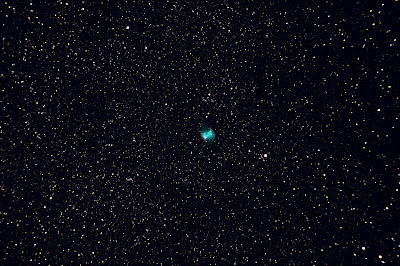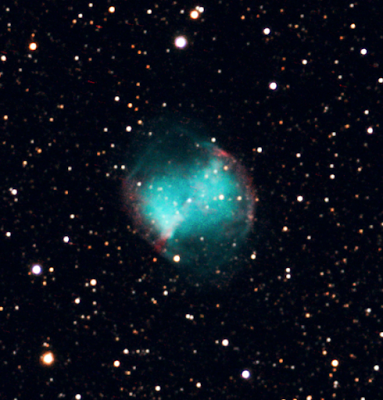Clear Skies: Day 1
 |
M 33 Galaxy (no cropping)
DeepSkyStacker 3.2.2 in Mac OS High Sierra (using Wine)
Total time: 20 minutes from 6 frames @ ISO 800
Canon T3i camera body (unmodified) , Daystar 80mm f/6 scope |
Last night was the first of perhaps a week of clear skies here in central Oregon... at least until the forestry department kicks in "prescribed burns" and pollutes the skies with smoke. I can't figure out why they can't do that on cloudy days. Sure, they want it to burn "hot and fast" but hey, what's the hurry? Throw some fire starter on it and it WILL burn! Anyway, enough of that rant...
My goal was to do some more tests with my autoguider camera and scope. Here is a close up of the same galaxy image above so you can see that the stars are round and there is no drift!
The real problem was not "How long can I expose the camera sensor?" but "How long can I expose before the background sky light overwhelms the faint nebulosity of the subject matter?"
Though the nights are coming on earlier, the problem is that, at present, until it is 11 pm or later the background sky light is too much for any serious imaging.
Of course, as fall progresses into winter here in the northern hemisphere it will get darker much earlier. That's the good news. The bad news is that these objects will be too far down in the west to image (trees, more atmosphere to shoot through). The good news: I will be ready for it next year!
Another task was to install
DeepSkyStacker onto my Macbook Pro running High Sierra 10.13.6
DSS was made only for Windows. While I could run it in a virtual machine using Virtual Box, the fact is that it would run far faster if not burdened down with another OS system.
Wine is a potential way of running DSS without the baggage of an entire Windows OS.
In my search for "How to run DSS in Mac" I came across this website:
https://creativecave.de/2017/11/23/deep-sky-stacker-for-mac/
This person has packaged Wine and DSS 3.2.2 into a SINGLE installable file! Sweet!
I used it for the above photograph (and the ones that follow) and it works GREAT on my Macbook!
Some functionality may be "limited" but that is not where I am going anyway (I haven't tested it fully).
Here is a screenshot of it running on my system:
The version of DSS is 3.2.2 which is older than the newer version 4.1.1 (available for 32 bit and 64 bit). I will try to find an easy way to install the newer version and see how it runs. Here is the DSS official website where 4.1.1 can be found.
http://deepskystacker.free.fr/english/index.html
Here are some more images stacked with DSS 3.2.2 last night:
 |
M 27 - The Dumbell Nebula
about 20 minutes from 7 images stacked - ISO 1600
Taken with the same camera and scope as the M 33 pic
|
 |
Zoomed in from the above shot (after post-processing with Luminar)
Notice there is no streaking, my autoguiding setup is WORKING! |
In my haste (which does make waste) I did not take any "dark" frames which would have eliminated "hot" pixels, some of which are obvious in the above image.
Now, for another night to further perfect my astroimaging...















